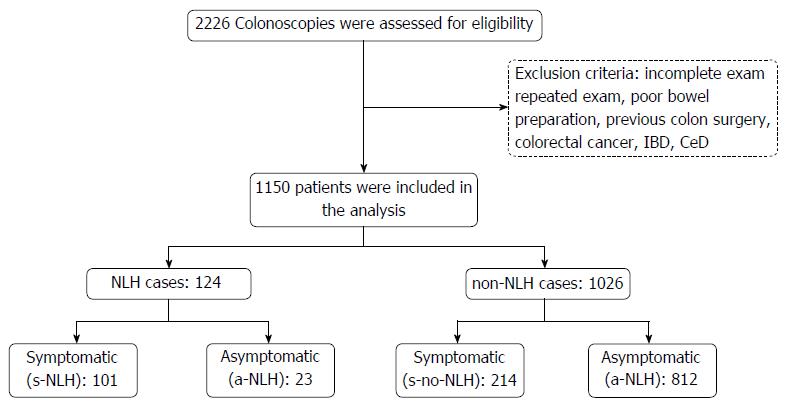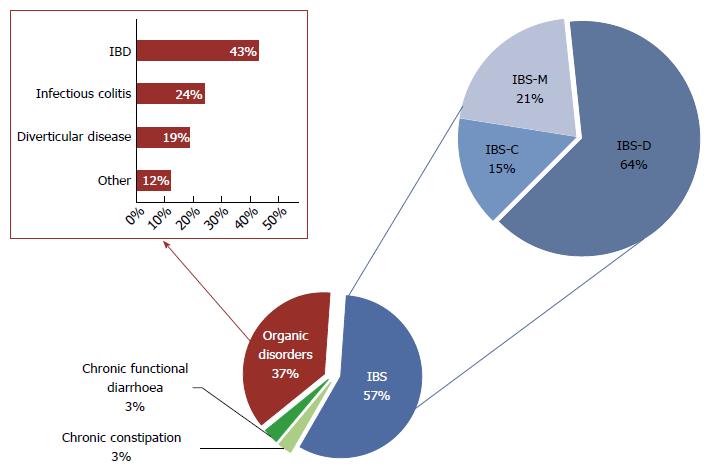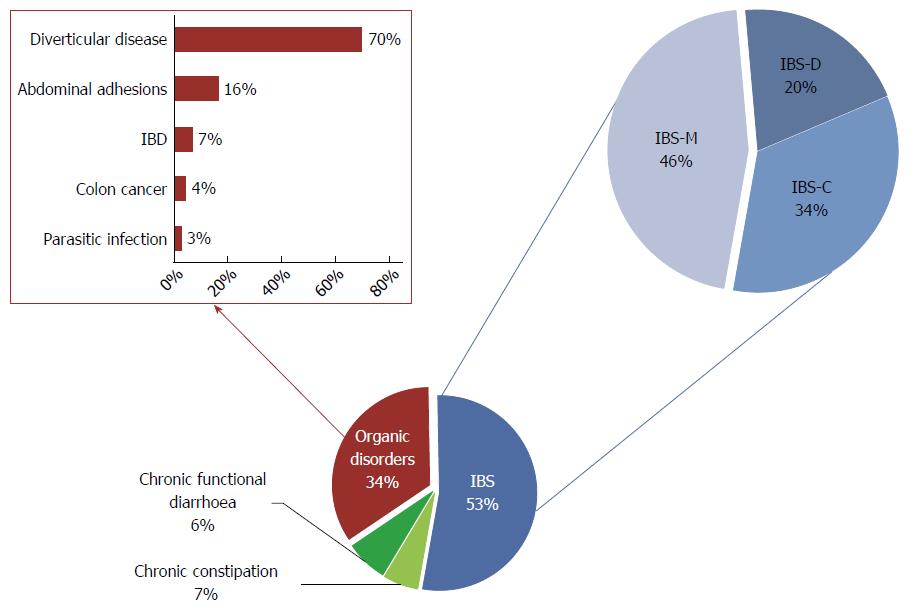Copyright
©The Author(s) 2016.
World J Gastroenterol. Dec 14, 2016; 22(46): 10198-10209
Published online Dec 14, 2016. doi: 10.3748/wjg.v22.i46.10198
Published online Dec 14, 2016. doi: 10.3748/wjg.v22.i46.10198
Figure 1 Study design.
NLH: Nodular lymphoid hyperplasia; s-no-NLH: Symptomatic patients without NLH; a-NLH: Asymptomatic subjects; s-NLH: Patients with nodular lymphoid hyperplasia; IBD: Inflammatory bowel disease; CeD: Celiac disease.
Figure 2 Endoscopic and histological features of nodular lymphoid hyperplasia.
A-F: Three typical cases of nodular lymphoid hyperplasia (NLH), as observed at white light (WL) standard endoscopy (A-C) and narrow band imaging (NBI) endoscopy (D-F), respectively. NLH appear as slightly raised whitish areas, usually < 5 mm in diameter, closely spaced, difficult to recognize at WL, and easier to observe by NBI; G and H: Show the histological appearance of NLH (hematoxylin-eosin staining), as clusters of ≤ 10 lymphoid nodules, composed of hyperplastic benign lymphoid tissue.
Figure 3 Final diagnosis for symptomatic patients with nodular lymphoid hyperplasia.
Patients with nodular lymphoid hyperplasia (s-NLH) patients were divided into organic and functional bowel disorders; the latter subset was further stratified into IBS with prevalent diarrhoea (IBS-D), or constipation (IBS-C), or mixed bowel habit (IBS-M), chronic functional diarrhoea, and chronic constipation, according to the Roma III criteria. Among organic conditions associated with NLH, the most frequent was IBD, followed by infections and diverticular disease. IBS: Irritable bowel syndrome; IBD: Inflammatory bowel disease.
Figure 4 Endoscopic features of nodular lymphoid hyperplasia with red ring sign, due to hypervascularization at the base of the follicles, associated with granulocyte infiltrate.
A and B: A typical case of nodular lymphoid hyperplasia (NLH) with red ring sign (RRS) and diffuse macroscopic inflammation, in white light (WL) and narrow band imaging (NBI), respectively: RRS appears as a red (WL) or brown (NBI) outline surrounding NLH foci; C and D: A particular of two NLH foci with RRS, in WL and NBI, respectively (black and white arrows).
Figure 5 Final diagnosis for symptomatic patients without nodular lymphoid hyperplasia.
IBS: Irritable bowel syndrome; IBS-M: IBS mixed bowel habit; IBS-C: IBS with prevalent constipation; IBS-D: IBS with prevalent diarrhoea; IBD: Inflammatory bowel disease.
Figure 6 Colonic nodular lymphoid hyperplasia in symptomatic patients constitutes a “minimal lesions colitis” that might be triggered by Nickel or other factors (such as immunodeficiency states, infections, hypersensitivity reactions, chronic constipation).
We speculate that minimal lesions colitis (MLC) could represent a distinct pathologic entity in a subset of irritable bowel syndrome (IBS) and systemic Ni allergy syndrome (SNAS) patients, and it might prelude to the development of inflammatory bowel disease (IBD).
- Citation: Piscaglia AC, Laterza L, Cesario V, Gerardi V, Landi R, Lopetuso LR, Calò G, Fabbretti G, Brisigotti M, Stefanelli ML, Gasbarrini A. Nodular lymphoid hyperplasia: A marker of low-grade inflammation in irritable bowel syndrome? World J Gastroenterol 2016; 22(46): 10198-10209
- URL: https://www.wjgnet.com/1007-9327/full/v22/i46/10198.htm
- DOI: https://dx.doi.org/10.3748/wjg.v22.i46.10198














